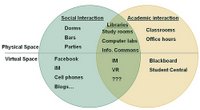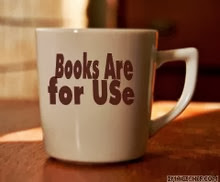This is a running post: Updated March 10, 2007:
Michael Stephens on The Culture of Trust
"The best libraries of the future will be those that...will seek to make that personal, emotional connection with users. It might be online, it might be in person, it might even be at Panera Bread. Walk through your library today and look at the story your library is telling with its space, signage, and ambience. Share yourself. Be human. Feel good about the difference you can make in your role as a guide for your users through this crazy, information-inundated world."
Listen to this article ...
Library 2.0 : An Academic's Perspective
I am quite excited to see a fellow SUNY librarian and a nationally known librarian blogging about Library 2.0 from the perspective of an academic. I have known Laura Cohen for may years and have served with her in the SUNY Librarians Association. Her new blog, Library 2.0: An Academic's Perspective, will be worht the time to read it. Her introductory post provides a good introduction and overview of Library 2.0. She quotes this list, from LITA President Bonnie Postletwaite, of what Library 2.0 basic concepts cover:Flexibility and nimbleness to enable rapid change
Commitment to continuous improvement based on assessment
Interactive and collaborative services driven by users needs
Taking the library to the users AND making the library a destination
Embracing radical trust
Use of new technological tools to accomplish the above
Laura then comes to the conclusion that "the last item is optional." I am in complete agreement.
Thanks to Bill Drew @ Baby Boomer Librarian for this reference
Interesting, thought provoking and synchronizing article by Maness. Thanks to Sukhdev for this info.
Library 2.0 Theory: Web 2.0 and Its Implications for Libraries, by Jack M. Maness, Webology, Volume 3, Number 2, June, 2006
Abstract
This article posits a definition and theory for "Library 2.0". It suggests that recent thinking describing the changing Web as "Web 2.0" will have substantial implications for libraries, and recognizes that while these implications keep very close to the history and mission of libraries, they still necessitate a new paradigm for librarianship. The paper applies the theory and definition to the practice of librarianship, specifically addressing how Web 2.0 technologies such as synchronous messaging and streaming media, blogs, wikis, social networks, tagging, RSS feeds, and mashups might intimate changes in how libraries provide access to their collections and user support for that access.
I love this - if you are looking for Library 2.0 ideas for your library, be sure to check out the Library 2.0 Idea Generator. This site randomly generates such gems as:
"remix Ranganathan's Laws using del.icio.us"
"engage microformats using LibraryThing"
"re-evaluate Stephen Abram using the Netflix model"
"repurpose Inter Library Loans just to annoy Michael Gorman"
"A library service on the web that is a combination of LibraryThing, Netvibes, IM-reference and Aquabrowser adapable to the individual needs and of course it should not be library dependent, but could incorporate content and services from all kinds of library-enteties.... Library 2.0 = MyLibrary? by lib1point5, 12 Apr 2006
See Also:
In an article, “Libraries urged to embrace Web2.0″, Mark Chillingworth makes the point that “that existing library catalogue standards, such as MARC and Z39.50, need to be replaced by XML technology “...
Here are some baby steps libraries can take.
1. Decide on what information a library wants to publish - catalogs, events, services, resources etc.
2. Design one or more Microformats for publishing the information
3. Integrate it into the current library web sites
continue reading
Technocrati Tags:
Web 2.0
Library2.0; and Library 2.0
Streaming media
Library Education
See also my previous post:





No comments:
Post a Comment